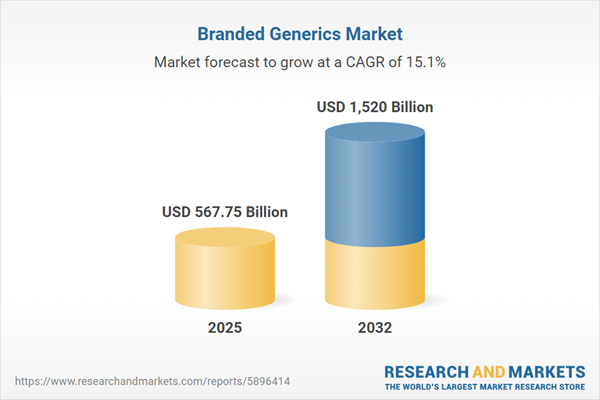Speak directly to the analyst to clarify any post sales queries you may have.
The branded generics market is evolving rapidly, shaped by regulatory changes, cost pressures, and advanced supply chain strategies. As healthcare systems seek reliable, affordable alternatives to innovator drugs, market participants must strategically navigate an increasingly complex environment to capture growth opportunities and ensure patient access.
Market Snapshot: Branded Generics Market Size and Growth
The Branded Generics Market grew from USD 494.29 billion in 2024 to USD 567.75 billion in 2025. It is expected to continue growing at a CAGR of 15.11%, reaching USD 1.52 trillion by 2032.
Scope & Segmentation
This report offers a comprehensive overview and segmentation of the branded generics market, enabling targeted strategies for manufacturers, distributors, and investors.
- Dosage Forms: Injections (intramuscular, intravenous, subcutaneous), Liquids (suspensions, syrups), Tablets & Capsules (extended release, immediate release), Topicals (creams, gels, ointments)
- Therapeutic Areas: Anti-infectives (antibiotics, antifungals, antivirals), Cardiovascular (anti-dyslipidemics, anti-hypertensives), Central Nervous System (anti-depressants, anti-epileptics, anti-psychotics), Gastrointestinal (antacids, laxatives), Pain Management (non-opioid analgesics, opioids)
- Applications: Animal health (companion animals: cats, dogs; livestock), Human health
- Distribution Channels: Drug stores, hospital pharmacies, online pharmacies (mobile apps, websites), retail pharmacies (chain, independent)
- Regions: Americas (United States, Canada, Mexico, Brazil, Argentina, Chile, Colombia, Peru), Europe, Middle East & Africa (including countries like United Kingdom, Germany, France, Russia, UAE, South Africa, Nigeria), Asia-Pacific (China, India, Japan, Australia, South Korea, Indonesia, Thailand, Malaysia, Singapore, Taiwan)
- Key Companies: Teva Pharmaceutical Industries Ltd, Sandoz International GmbH, Fresenius Kabi AG, Viatris Inc, Sun Pharmaceutical Industries Ltd, Dr. Reddy's Laboratories Ltd, Lupin Ltd, Cipla Ltd, Aurobindo Pharma Ltd, Glenmark Pharmaceuticals Ltd
Key Takeaways for Senior Decision-Makers
- Branded generics bridge the gap between costly innovator drugs and traditional generics, offering strong reliability and value to healthcare providers and patients.
- Market participants are realigning portfolios and leveraging mid-tier branded generics to drive patient adherence, access, and brand loyalty.
- Digital health integration, including real-world evidence and smart packaging, is helping to differentiate brands and improve engagement outcomes across therapeutic areas.
- Changing regulatory landscapes, with accelerated approval pathways and harmonization efforts, are reshaping market entry strategies and encouraging manufacturers to strengthen clinical, safety, and pharmacovigilance practices.
- Industry consolidation through mergers, acquisitions, and partnerships is fostering diversified product pipelines and more agile response to market needs.
Tariff Impact: Strategic Response to U.S. Policy Shifts
Recent revisions in United States tariff policies have triggered a realignment of sourcing and manufacturing strategies for branded generic pharmaceuticals. Companies are actively diversifying supply chains, with greater emphasis on regional hubs and domestic investments to offset increased duty costs and preserve operational continuity. Strategic supplier negotiations and selective facility expansions are helping mitigate risks associated with these trade policy changes while maintaining competitive pricing for end markets.
Methodology & Data Sources
The analysis is grounded in an extensive blend of secondary research—such as review of journals, regulatory filings, and industry papers—and primary data obtained from industry experts and senior executives. Advanced market segmentation, scenario planning, and sensitivity analyses support accuracy and actionable insight. Findings are validated through repeated expert review, minimizing biases and reflecting evolving real-world dynamics.
Why This Report Matters
- Enables data-driven strategy formulation for portfolio optimization, regional expansion, and targeted investment within the branded generics sector.
- Equips senior leaders with actionable intelligence on supply chain resilience, digital transformation, and market access considerations in a complex regulatory landscape.
- Uncovers emerging opportunities across technology adoption, therapeutic innovation, and competitive positioning, facilitating informed, sustainable growth decisions.
Conclusion
The branded generics market is poised for sustained expansion, propelled by regulatory support, technology integration, and growing demand across diverse healthcare settings. Stakeholders equipped with the right insights can navigate change, capture value, and drive reliable access for patients globally.
Additional Product Information:
- Purchase of this report includes 1 year online access with quarterly updates.
- This report can be updated on request. Please contact our Customer Experience team using the Ask a Question widget on our website.
Table of Contents
3. Executive Summary
4. Market Overview
7. Cumulative Impact of Artificial Intelligence 2025
Companies Mentioned
The companies profiled in this Branded Generics market report include:- Teva Pharmaceutical Industries Ltd
- Sandoz International GmbH
- Fresenius Kabi AG
- Viatris Inc
- Sun Pharmaceutical Industries Ltd
- Dr. Reddy's Laboratories Ltd
- Lupin Ltd
- Cipla Ltd
- Aurobindo Pharma Ltd
- Glenmark Pharmaceuticals Ltd
Table Information
| Report Attribute | Details |
|---|---|
| No. of Pages | 183 |
| Published | October 2025 |
| Forecast Period | 2025 - 2032 |
| Estimated Market Value ( USD | $ 567.75 Billion |
| Forecasted Market Value ( USD | $ 1520 Billion |
| Compound Annual Growth Rate | 15.1% |
| Regions Covered | Global |
| No. of Companies Mentioned | 11 |









